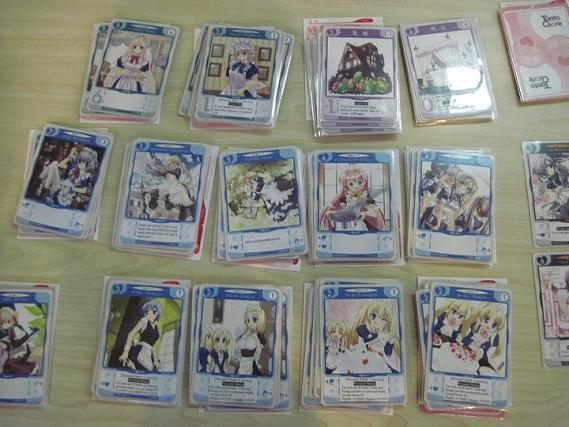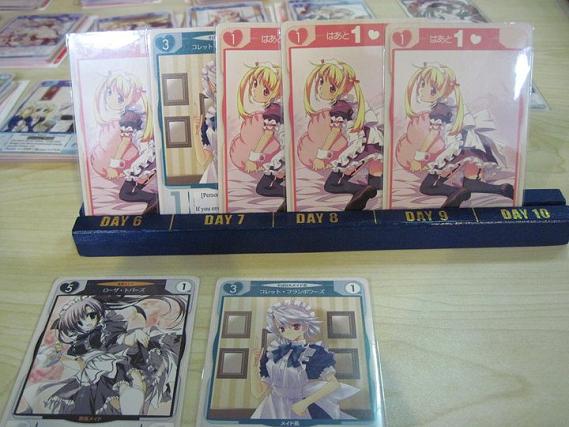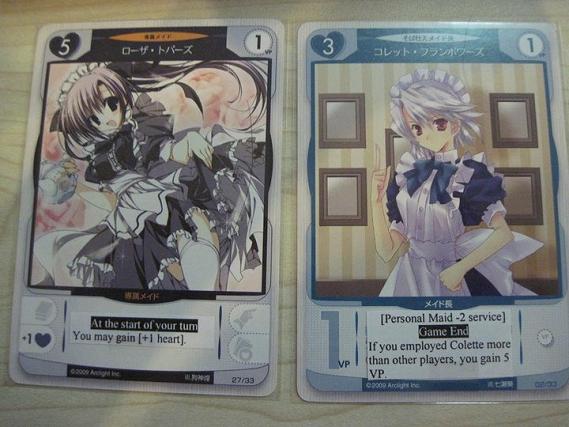
I have to admit to a fair amount of skepticism when I first learned about the existence of this game. One reason is that Sean described it as the Japanese-version of Dominion with a maid theme, so unless it brings something drastically new to the table, I’m inclined to dismiss it (yes, even though I did try to design a Dominion-like game myself). The other reason is that I’m not terribly fond of cutesy anime tropes. Yes, my wife and I enjoyed Bleach back when it was good and we’re actually watching Naruto Shippuden now, but I draw the line at the girly stuff.
Still, I figured that since it’s so similar to Dominion, learning it would take no time at all and a single game should go by rather quickly, so we gave it a shot. Since everyone and their mother should know how to play Dominion by now, it’s easiest just to explain the differences. First, the terms used are obviously different but refer to the same concepts. Treasure coins have been replaced by hearts. Actions are called services. To employ a maid means to buy a card. One cool thing that Tanto Cuore does is to specify card effects through standardized icons instead of in the card text. So a card that has +1 in the draw card space, +1 in the hearts space and +1 in the services space lets you draw one card, provides one heart to spend and gives you one extra action when played.
Secondly, Tanto Cuore rebalances some costs. The 1 heart, 2 heart and 3 heart cards cost 1, 4 and 7 hearts respectively to buy. There also appears to be only two standard Victory Point cards. The card that’s worth 6 points costs a whopping 9 hearts. The other one is only worth 1 point and costs 3 hearts to buy. This is the card that all players have in their decks to start with as chaff. In our game, we also had two extra cards that I’m not sure are supposed to be standard or are varied from game to game. One card is worth negative points much like the curse cards in Dominion, but players buy them as they would any other card and choose an opponent to give the card to. The other card is likewise a targeted attack, only this one disables a maid that an opponent has played into his personal space.

This brings us to the next point of difference from the basic Dominion set. Some of the maid cards can be played onto the table by spending one or more services. The one point VP card that I mentioned earlier for example requires two services to be played onto the table which is only possible if you play a card which provides extra services. Generally you get a one-time card effect when you do so but the bigger benefit is that your deck doesn’t get clogged with chaff. The best thing about doing this is that you also get bonus VP at the end of the game. Some of the bonus effects we saw were 5 VPs to the player having the most number of this maid type on the table, bonus VPs with varying values for each set of up to four of a specific type of maid, and collecting sets consisting of three different maid cards.
Finally, there is a stack of private maid cards which look very different from the rest due to their black borders. Each card in this stack is unique and two of them are turned face up to be employable by players at any one time. These cards immediately go into the player’s personal space when bought and provide permanent benefits as long as they’re there. Only one such private maid can be active at a time however, so buying a new one will disable the older one. They seem to have a wide variety of effects. My wife used one that allowed her to draw one random card from a chosen opponent’s hand, look at it and decide whether or not she wants it for herself. If she does, she must allow the opponent to draw one card from her own hand. The exchange of cards is permanent.
So how does it play? Surprisingly well and refreshingly different from Dominion, I have to say. Our session lasted much longer than the typical Dominion game, even though in Tanto Cuore you only have to exhaust two stacks of cards to finish the game (the hearts stacks don’t count for this purpose however, and we finished the two heart and three heart stacks in short order). Sean attributed this to our unfamiliarity with the cards but while this was certainly a factor, I believe that this game is also somewhat more complex than at least the basic set of Dominion. Trying to decide which maid set to collect for the bonus VPs requires taking into account the maid cards other players have bought or played onto the table. The ability to actively hurt a target opponent is another source of complication.

In our three player game, I was the first to be able to afford to buy the 6-point VP cards partly because my private maid gave me a bonus heart every turn. Due to this, I was especially fearful of my wife’s private maid as she might get lucky with it and snag the expensive card right out of my hand. So I eventually bought the sickness card that disabled my wife’s private maid even though I knew that doing so made me lose a turn, benefiting Sean. It was a situation that wouldn’t have occurred in basic Dominion. Similarly, despite some trepidation I was the one who chose to end the game by buying two cards in one turn but lost to Sean by a mere 1 point. I guess buying a negative VP card and giving it to him would have helped me in that game, especially as I knew that my wife was behind both of us in points.
Since we only played one game and I didn’t see the rest of the cards, I can’t really comment much on game balance which is key in a game like this. I do note that the private maids feel oddly powerful. Sure, you’re only supposed to have one, but their benefits are so manifestly useful relative to their cost, plus the fact that they immediately come into play when bought, all but ensures that all players will make one of these their first buy if at all possible. Also, in Dominion, players have commented that many cards fail the silver test in most situations. If you can afford to buy a silver, you almost always want to buy a silver. I’m amused to see that Tanto Cuore “solves” this dilemma by being extremely stingy with the heart cards. There are so few of them that players need to fight over them. Once they’re all gone, you’re completely free to evaluate the usefulness of other cards. By contrast, I’ve never seen a Dominion game run out of silver or gold.
Anyway, from what I can tell, Tanto Cuore is a perfectly serviceable game. It does come with only 20 different cards that vary from game to game compared to the 25 in Dominion, so in theory, it should be slightly less replayable, but it can’t really compete at all once you add the extra mechanics and cards from the Dominion expansions that are starting to pile up. As for theme, while I don’t care much for the maid stuff and find the images borderline ecchi (note: I don’t mind sexy, but conflating juvenile cuteness with sexiness makes me a bit uncomfortable), I have to admit that it’s more novel and more coherent than the blandness that is Dominion. I do wonder at the target demographic this game is supposed to reach. Is there really that many people in the intersection between the set of people who love cute anime girls in maid costumes and the set of people who would enjoy a deckbuilding boardgame with a fair amount of complexity?
One Response to “Tanto Cuore”
Thanks for the information here. Sounds like a very interesting card game t oplay
Leave a Reply